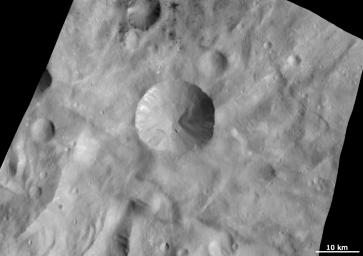This Dawn FC (framing camera) image is centered on the Sextilia crater in Vesta's southern hemisphere. Craters on Vesta are named after Vestal virgins, priestesses of the Roman goddess Vesta. The Sextilia crater is a large, approximately 15km diameter, and distinctive crater so its name is used to name the quadrangle in which it is located. Sextilia crater is distinctive because it has a fresh, sharp rim which is also scalloped in shape. It also contains outcrops of both bright and dark material. These originate along its rim and sides and slump towards the center of the crater. There are some especially large slumps of material on the right side of the crater. Surrounding Sextilia crater is the hummocky (i.e., wavy/undulating) terrain of Vesta's southern hemisphere and some dark and bright rayed craters. The small dark rayed crater, and its larger neighbor, in the top of the image are the same craters which are in the bottom right of the "Dark material associated with and between craters" Image of the Day.
This image is in Vesta's Sextilia quadrangle and the center latitude and longitude of the image is 39.5°S, 155.7°E. NASA's Dawn spacecraft obtained this image with its framing camera on October 10th 2011. This image was taken through the camera's clear filter. The distance to the surface of Vesta is 702 km and the image has a resolution of about 70 meters per pixel. This image was acquired during the HAMO (High Altitude Mapping Orbit) phase of the mission.
The Dawn mission to Vesta and Ceres is managed by NASA's Jet Propulsion Laboratory, a division of the California Institute of Technology in Pasadena, for NASA's Science Mission Directorate, Washington D.C. UCLA is responsible for overall Dawn mission science. Dawn's VIR was provided by ASI, the Italian Space Agency and is managed by INAF, Italy's National Institute for Astrophysics, in collaboration with Selex Galileo, where it was built.
More information about Dawn is online at http://www.nasa.gov/dawn and http://dawn.jpl.nasa.gov.

 Planetary Data System
Planetary Data System












